Financial Crisis: Insurance Sector Perspective
VerifiedAdded on 2019/09/26
|11
|2363
|202
Essay
AI Summary
This essay examines the impact of the 2008 financial crisis on the insurance sector, focusing on the role of credit default swaps (CDS). It details how the crisis affected various segments, including US mortgage insurance companies, life insurance companies, financial guarantee insurance companies, and insurance-dominated financial groups like AIG. The essay highlights the significant losses incurred by these entities, particularly AIG's USD 60 billion loss in Q1 2009, leading to government intervention. Furthermore, it discusses lessons learned from the crisis, such as the importance of robust risk management, transparent valuations, and a more effective regulatory framework. The essay concludes by emphasizing the insurance sector's role as a shock absorber during the crisis, despite the challenges faced by specific segments, and the need for simpler structures and financial instruments to enhance transparency and reduce systemic risk.
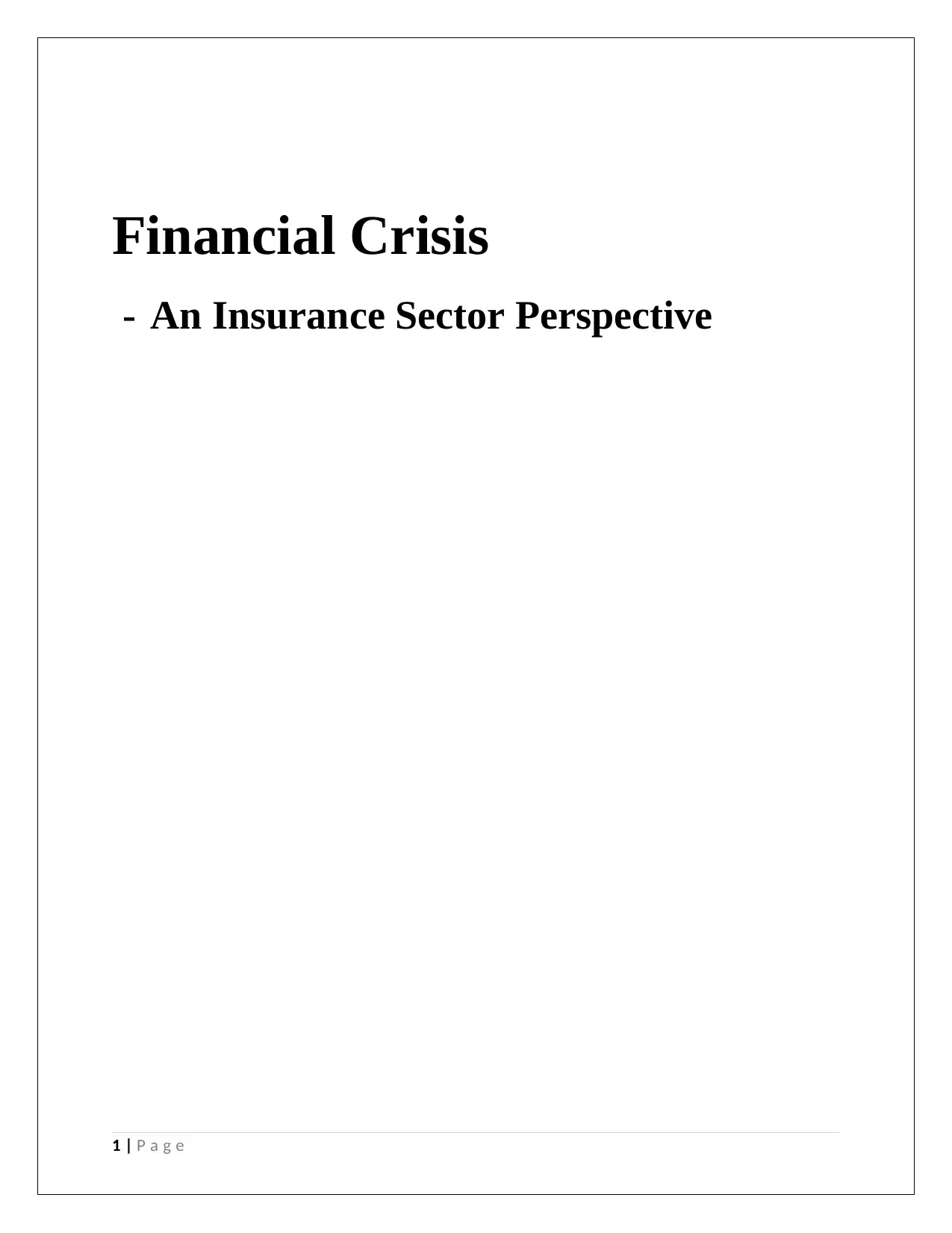
Financial Crisis
- An Insurance Sector Perspective
1 | P a g e
- An Insurance Sector Perspective
1 | P a g e
Paraphrase This Document
Need a fresh take? Get an instant paraphrase of this document with our AI Paraphraser
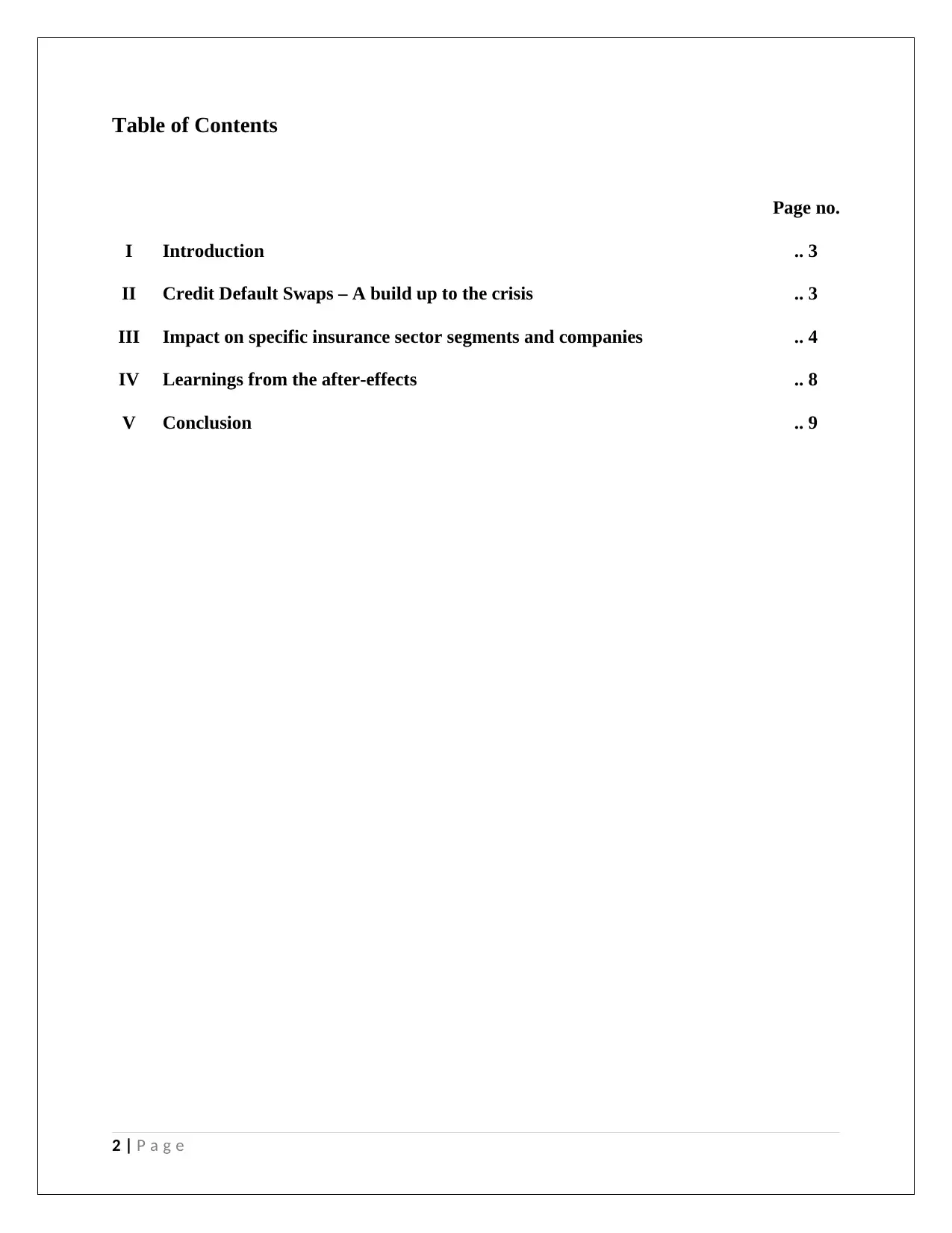
Table of Contents
Page no.
I Introduction .. 3
II Credit Default Swaps – A build up to the crisis .. 3
III Impact on specific insurance sector segments and companies .. 4
IV Learnings from the after-effects .. 8
V Conclusion .. 9
2 | P a g e
Page no.
I Introduction .. 3
II Credit Default Swaps – A build up to the crisis .. 3
III Impact on specific insurance sector segments and companies .. 4
IV Learnings from the after-effects .. 8
V Conclusion .. 9
2 | P a g e
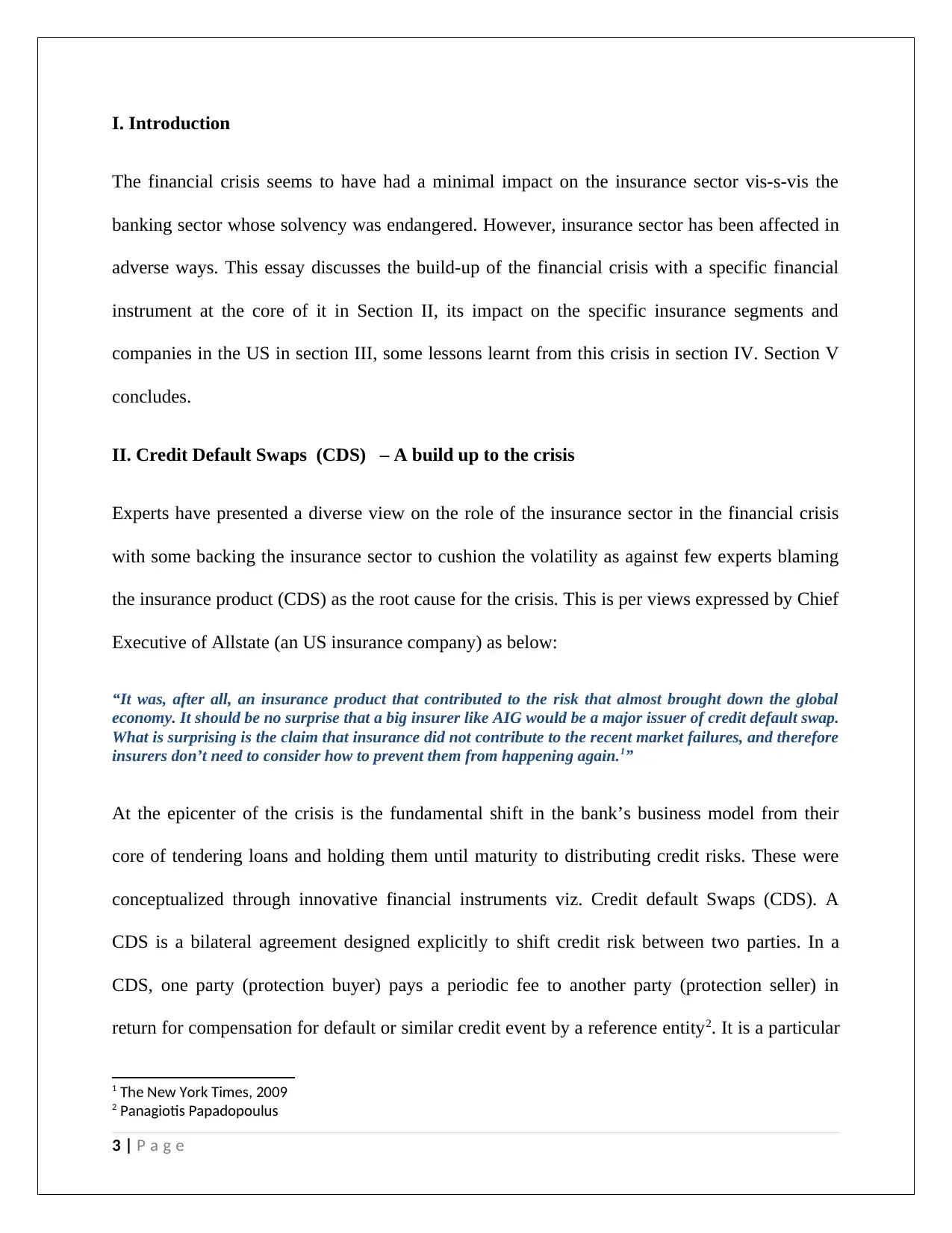
I. Introduction
The financial crisis seems to have had a minimal impact on the insurance sector vis-s-vis the
banking sector whose solvency was endangered. However, insurance sector has been affected in
adverse ways. This essay discusses the build-up of the financial crisis with a specific financial
instrument at the core of it in Section II, its impact on the specific insurance segments and
companies in the US in section III, some lessons learnt from this crisis in section IV. Section V
concludes.
II. Credit Default Swaps (CDS) – A build up to the crisis
Experts have presented a diverse view on the role of the insurance sector in the financial crisis
with some backing the insurance sector to cushion the volatility as against few experts blaming
the insurance product (CDS) as the root cause for the crisis. This is per views expressed by Chief
Executive of Allstate (an US insurance company) as below:
“It was, after all, an insurance product that contributed to the risk that almost brought down the global
economy. It should be no surprise that a big insurer like AIG would be a major issuer of credit default swap.
What is surprising is the claim that insurance did not contribute to the recent market failures, and therefore
insurers don’t need to consider how to prevent them from happening again.1”
At the epicenter of the crisis is the fundamental shift in the bank’s business model from their
core of tendering loans and holding them until maturity to distributing credit risks. These were
conceptualized through innovative financial instruments viz. Credit default Swaps (CDS). A
CDS is a bilateral agreement designed explicitly to shift credit risk between two parties. In a
CDS, one party (protection buyer) pays a periodic fee to another party (protection seller) in
return for compensation for default or similar credit event by a reference entity2. It is a particular
1 The New York Times, 2009
2 Panagiotis Papadopoulus
3 | P a g e
The financial crisis seems to have had a minimal impact on the insurance sector vis-s-vis the
banking sector whose solvency was endangered. However, insurance sector has been affected in
adverse ways. This essay discusses the build-up of the financial crisis with a specific financial
instrument at the core of it in Section II, its impact on the specific insurance segments and
companies in the US in section III, some lessons learnt from this crisis in section IV. Section V
concludes.
II. Credit Default Swaps (CDS) – A build up to the crisis
Experts have presented a diverse view on the role of the insurance sector in the financial crisis
with some backing the insurance sector to cushion the volatility as against few experts blaming
the insurance product (CDS) as the root cause for the crisis. This is per views expressed by Chief
Executive of Allstate (an US insurance company) as below:
“It was, after all, an insurance product that contributed to the risk that almost brought down the global
economy. It should be no surprise that a big insurer like AIG would be a major issuer of credit default swap.
What is surprising is the claim that insurance did not contribute to the recent market failures, and therefore
insurers don’t need to consider how to prevent them from happening again.1”
At the epicenter of the crisis is the fundamental shift in the bank’s business model from their
core of tendering loans and holding them until maturity to distributing credit risks. These were
conceptualized through innovative financial instruments viz. Credit default Swaps (CDS). A
CDS is a bilateral agreement designed explicitly to shift credit risk between two parties. In a
CDS, one party (protection buyer) pays a periodic fee to another party (protection seller) in
return for compensation for default or similar credit event by a reference entity2. It is a particular
1 The New York Times, 2009
2 Panagiotis Papadopoulus
3 | P a g e
⊘ This is a preview!⊘
Do you want full access?
Subscribe today to unlock all pages.

Trusted by 1+ million students worldwide
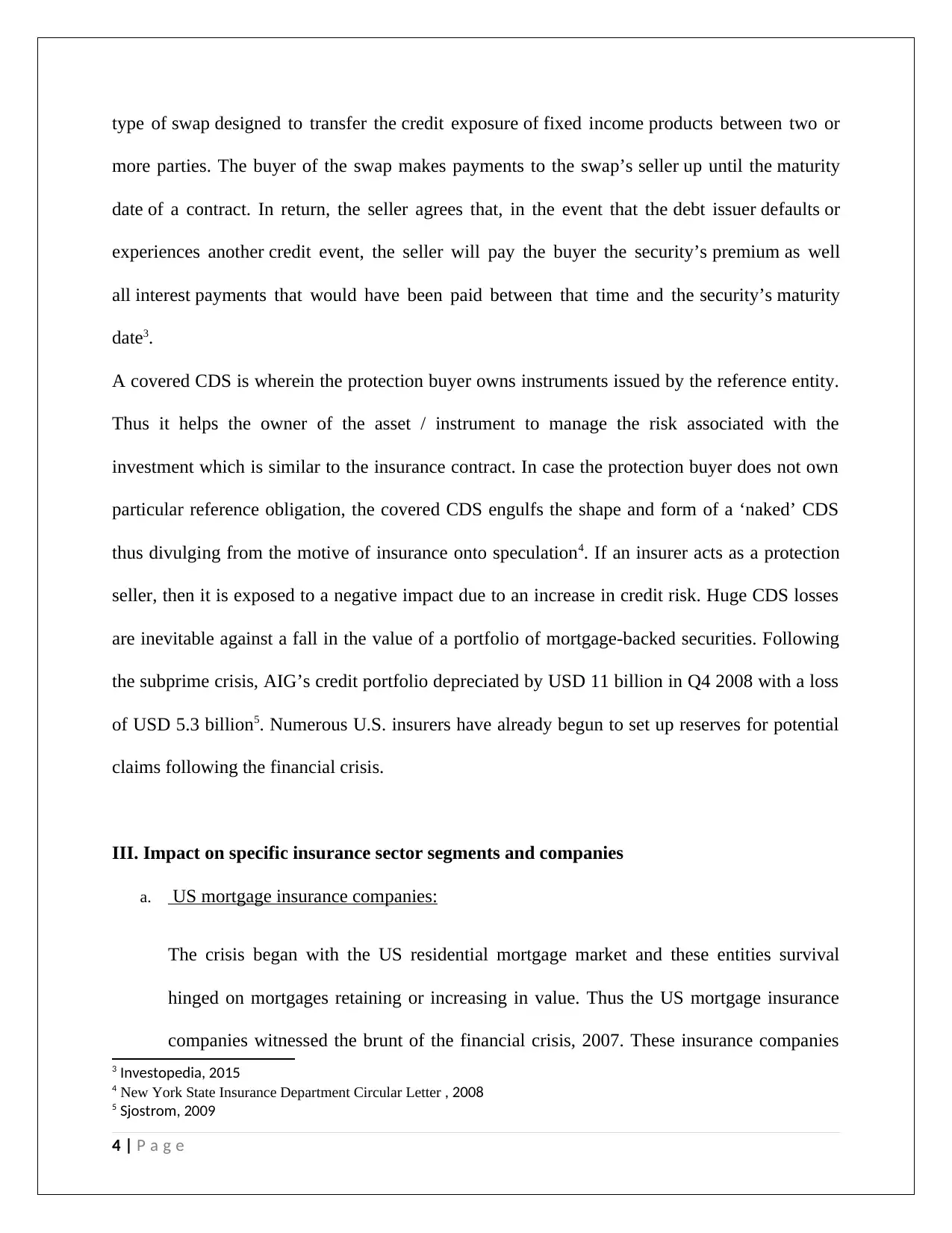
type of swap designed to transfer the credit exposure of fixed income products between two or
more parties. The buyer of the swap makes payments to the swap’s seller up until the maturity
date of a contract. In return, the seller agrees that, in the event that the debt issuer defaults or
experiences another credit event, the seller will pay the buyer the security’s premium as well
all interest payments that would have been paid between that time and the security’s maturity
date3.
A covered CDS is wherein the protection buyer owns instruments issued by the reference entity.
Thus it helps the owner of the asset / instrument to manage the risk associated with the
investment which is similar to the insurance contract. In case the protection buyer does not own
particular reference obligation, the covered CDS engulfs the shape and form of a ‘naked’ CDS
thus divulging from the motive of insurance onto speculation4. If an insurer acts as a protection
seller, then it is exposed to a negative impact due to an increase in credit risk. Huge CDS losses
are inevitable against a fall in the value of a portfolio of mortgage-backed securities. Following
the subprime crisis, AIG’s credit portfolio depreciated by USD 11 billion in Q4 2008 with a loss
of USD 5.3 billion5. Numerous U.S. insurers have already begun to set up reserves for potential
claims following the financial crisis.
III. Impact on specific insurance sector segments and companies
a. US mortgage insurance companies:
The crisis began with the US residential mortgage market and these entities survival
hinged on mortgages retaining or increasing in value. Thus the US mortgage insurance
companies witnessed the brunt of the financial crisis, 2007. These insurance companies
3 Investopedia, 2015
4 New York State Insurance Department Circular Letter , 2008
5 Sjostrom, 2009
4 | P a g e
more parties. The buyer of the swap makes payments to the swap’s seller up until the maturity
date of a contract. In return, the seller agrees that, in the event that the debt issuer defaults or
experiences another credit event, the seller will pay the buyer the security’s premium as well
all interest payments that would have been paid between that time and the security’s maturity
date3.
A covered CDS is wherein the protection buyer owns instruments issued by the reference entity.
Thus it helps the owner of the asset / instrument to manage the risk associated with the
investment which is similar to the insurance contract. In case the protection buyer does not own
particular reference obligation, the covered CDS engulfs the shape and form of a ‘naked’ CDS
thus divulging from the motive of insurance onto speculation4. If an insurer acts as a protection
seller, then it is exposed to a negative impact due to an increase in credit risk. Huge CDS losses
are inevitable against a fall in the value of a portfolio of mortgage-backed securities. Following
the subprime crisis, AIG’s credit portfolio depreciated by USD 11 billion in Q4 2008 with a loss
of USD 5.3 billion5. Numerous U.S. insurers have already begun to set up reserves for potential
claims following the financial crisis.
III. Impact on specific insurance sector segments and companies
a. US mortgage insurance companies:
The crisis began with the US residential mortgage market and these entities survival
hinged on mortgages retaining or increasing in value. Thus the US mortgage insurance
companies witnessed the brunt of the financial crisis, 2007. These insurance companies
3 Investopedia, 2015
4 New York State Insurance Department Circular Letter , 2008
5 Sjostrom, 2009
4 | P a g e
Paraphrase This Document
Need a fresh take? Get an instant paraphrase of this document with our AI Paraphraser
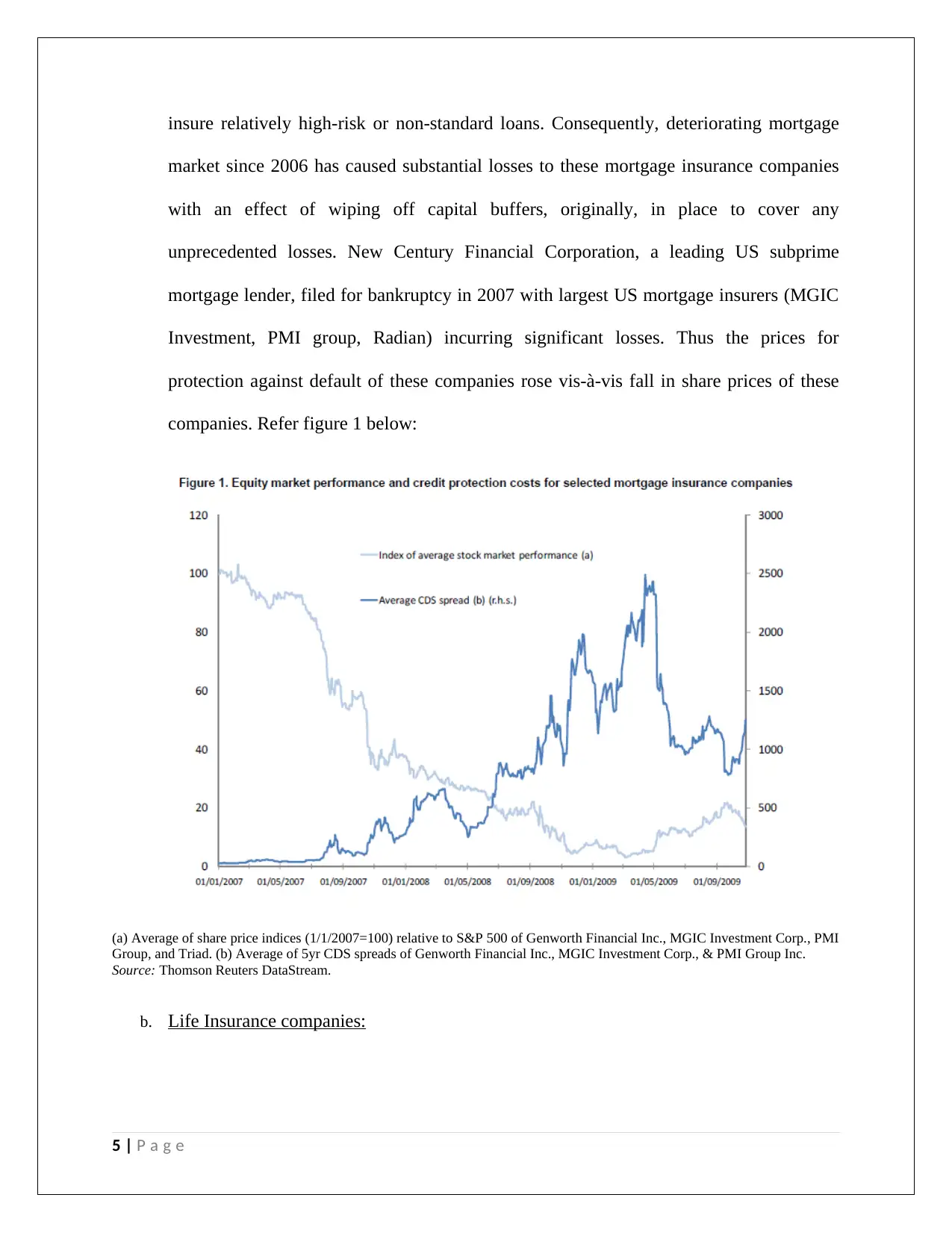
insure relatively high-risk or non-standard loans. Consequently, deteriorating mortgage
market since 2006 has caused substantial losses to these mortgage insurance companies
with an effect of wiping off capital buffers, originally, in place to cover any
unprecedented losses. New Century Financial Corporation, a leading US subprime
mortgage lender, filed for bankruptcy in 2007 with largest US mortgage insurers (MGIC
Investment, PMI group, Radian) incurring significant losses. Thus the prices for
protection against default of these companies rose vis-à-vis fall in share prices of these
companies. Refer figure 1 below:
(a) Average of share price indices (1/1/2007=100) relative to S&P 500 of Genworth Financial Inc., MGIC Investment Corp., PMI
Group, and Triad. (b) Average of 5yr CDS spreads of Genworth Financial Inc., MGIC Investment Corp., & PMI Group Inc.
Source: Thomson Reuters DataStream.
b. Life Insurance companies:
5 | P a g e
market since 2006 has caused substantial losses to these mortgage insurance companies
with an effect of wiping off capital buffers, originally, in place to cover any
unprecedented losses. New Century Financial Corporation, a leading US subprime
mortgage lender, filed for bankruptcy in 2007 with largest US mortgage insurers (MGIC
Investment, PMI group, Radian) incurring significant losses. Thus the prices for
protection against default of these companies rose vis-à-vis fall in share prices of these
companies. Refer figure 1 below:
(a) Average of share price indices (1/1/2007=100) relative to S&P 500 of Genworth Financial Inc., MGIC Investment Corp., PMI
Group, and Triad. (b) Average of 5yr CDS spreads of Genworth Financial Inc., MGIC Investment Corp., & PMI Group Inc.
Source: Thomson Reuters DataStream.
b. Life Insurance companies:
5 | P a g e
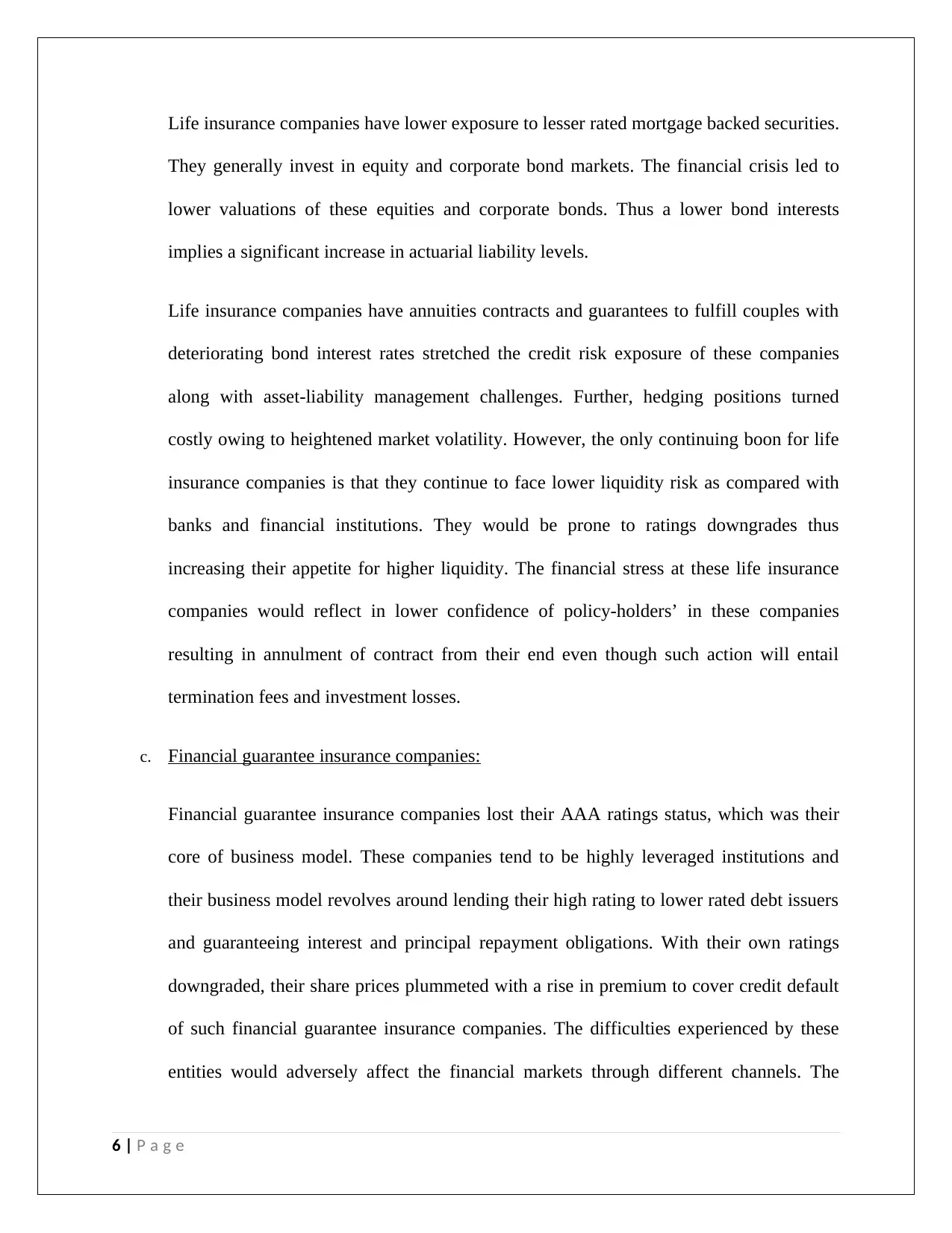
Life insurance companies have lower exposure to lesser rated mortgage backed securities.
They generally invest in equity and corporate bond markets. The financial crisis led to
lower valuations of these equities and corporate bonds. Thus a lower bond interests
implies a significant increase in actuarial liability levels.
Life insurance companies have annuities contracts and guarantees to fulfill couples with
deteriorating bond interest rates stretched the credit risk exposure of these companies
along with asset-liability management challenges. Further, hedging positions turned
costly owing to heightened market volatility. However, the only continuing boon for life
insurance companies is that they continue to face lower liquidity risk as compared with
banks and financial institutions. They would be prone to ratings downgrades thus
increasing their appetite for higher liquidity. The financial stress at these life insurance
companies would reflect in lower confidence of policy-holders’ in these companies
resulting in annulment of contract from their end even though such action will entail
termination fees and investment losses.
c. Financial guarantee insurance companies:
Financial guarantee insurance companies lost their AAA ratings status, which was their
core of business model. These companies tend to be highly leveraged institutions and
their business model revolves around lending their high rating to lower rated debt issuers
and guaranteeing interest and principal repayment obligations. With their own ratings
downgraded, their share prices plummeted with a rise in premium to cover credit default
of such financial guarantee insurance companies. The difficulties experienced by these
entities would adversely affect the financial markets through different channels. The
6 | P a g e
They generally invest in equity and corporate bond markets. The financial crisis led to
lower valuations of these equities and corporate bonds. Thus a lower bond interests
implies a significant increase in actuarial liability levels.
Life insurance companies have annuities contracts and guarantees to fulfill couples with
deteriorating bond interest rates stretched the credit risk exposure of these companies
along with asset-liability management challenges. Further, hedging positions turned
costly owing to heightened market volatility. However, the only continuing boon for life
insurance companies is that they continue to face lower liquidity risk as compared with
banks and financial institutions. They would be prone to ratings downgrades thus
increasing their appetite for higher liquidity. The financial stress at these life insurance
companies would reflect in lower confidence of policy-holders’ in these companies
resulting in annulment of contract from their end even though such action will entail
termination fees and investment losses.
c. Financial guarantee insurance companies:
Financial guarantee insurance companies lost their AAA ratings status, which was their
core of business model. These companies tend to be highly leveraged institutions and
their business model revolves around lending their high rating to lower rated debt issuers
and guaranteeing interest and principal repayment obligations. With their own ratings
downgraded, their share prices plummeted with a rise in premium to cover credit default
of such financial guarantee insurance companies. The difficulties experienced by these
entities would adversely affect the financial markets through different channels. The
6 | P a g e
⊘ This is a preview!⊘
Do you want full access?
Subscribe today to unlock all pages.

Trusted by 1+ million students worldwide
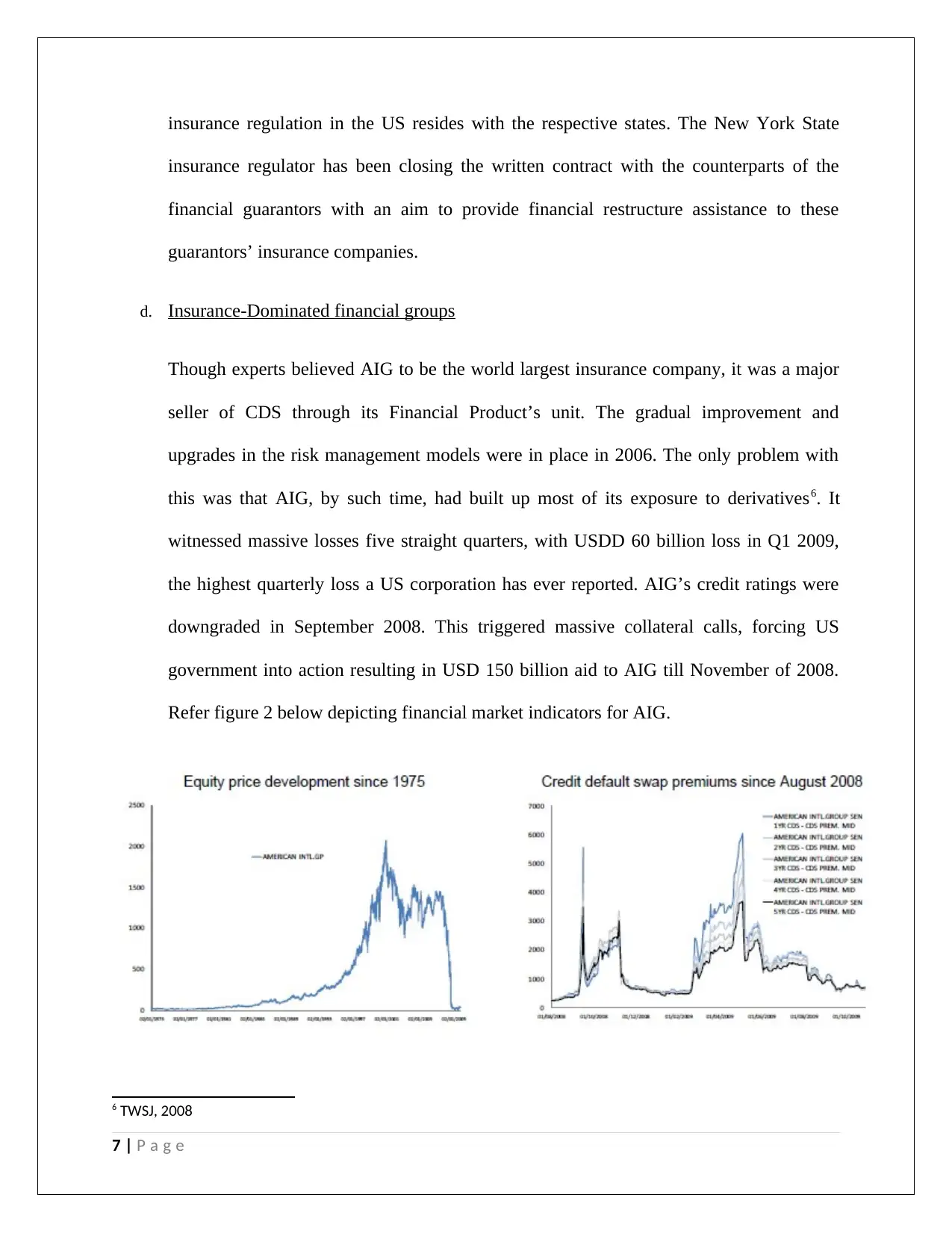
insurance regulation in the US resides with the respective states. The New York State
insurance regulator has been closing the written contract with the counterparts of the
financial guarantors with an aim to provide financial restructure assistance to these
guarantors’ insurance companies.
d. Insurance-Dominated financial groups
Though experts believed AIG to be the world largest insurance company, it was a major
seller of CDS through its Financial Product’s unit. The gradual improvement and
upgrades in the risk management models were in place in 2006. The only problem with
this was that AIG, by such time, had built up most of its exposure to derivatives6. It
witnessed massive losses five straight quarters, with USDD 60 billion loss in Q1 2009,
the highest quarterly loss a US corporation has ever reported. AIG’s credit ratings were
downgraded in September 2008. This triggered massive collateral calls, forcing US
government into action resulting in USD 150 billion aid to AIG till November of 2008.
Refer figure 2 below depicting financial market indicators for AIG.
6 TWSJ, 2008
7 | P a g e
insurance regulator has been closing the written contract with the counterparts of the
financial guarantors with an aim to provide financial restructure assistance to these
guarantors’ insurance companies.
d. Insurance-Dominated financial groups
Though experts believed AIG to be the world largest insurance company, it was a major
seller of CDS through its Financial Product’s unit. The gradual improvement and
upgrades in the risk management models were in place in 2006. The only problem with
this was that AIG, by such time, had built up most of its exposure to derivatives6. It
witnessed massive losses five straight quarters, with USDD 60 billion loss in Q1 2009,
the highest quarterly loss a US corporation has ever reported. AIG’s credit ratings were
downgraded in September 2008. This triggered massive collateral calls, forcing US
government into action resulting in USD 150 billion aid to AIG till November of 2008.
Refer figure 2 below depicting financial market indicators for AIG.
6 TWSJ, 2008
7 | P a g e
Paraphrase This Document
Need a fresh take? Get an instant paraphrase of this document with our AI Paraphraser
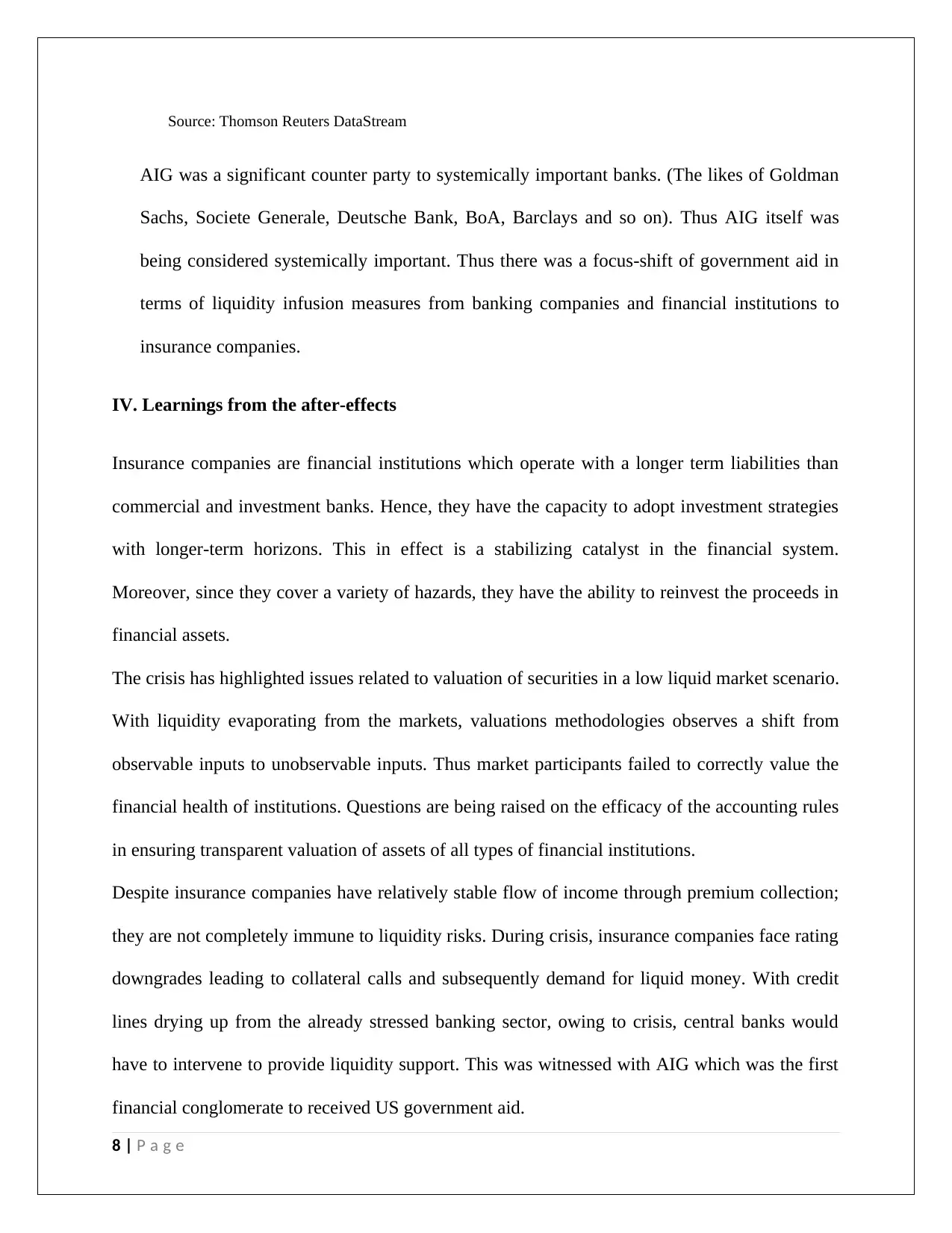
Source: Thomson Reuters DataStream
AIG was a significant counter party to systemically important banks. (The likes of Goldman
Sachs, Societe Generale, Deutsche Bank, BoA, Barclays and so on). Thus AIG itself was
being considered systemically important. Thus there was a focus-shift of government aid in
terms of liquidity infusion measures from banking companies and financial institutions to
insurance companies.
IV. Learnings from the after-effects
Insurance companies are financial institutions which operate with a longer term liabilities than
commercial and investment banks. Hence, they have the capacity to adopt investment strategies
with longer-term horizons. This in effect is a stabilizing catalyst in the financial system.
Moreover, since they cover a variety of hazards, they have the ability to reinvest the proceeds in
financial assets.
The crisis has highlighted issues related to valuation of securities in a low liquid market scenario.
With liquidity evaporating from the markets, valuations methodologies observes a shift from
observable inputs to unobservable inputs. Thus market participants failed to correctly value the
financial health of institutions. Questions are being raised on the efficacy of the accounting rules
in ensuring transparent valuation of assets of all types of financial institutions.
Despite insurance companies have relatively stable flow of income through premium collection;
they are not completely immune to liquidity risks. During crisis, insurance companies face rating
downgrades leading to collateral calls and subsequently demand for liquid money. With credit
lines drying up from the already stressed banking sector, owing to crisis, central banks would
have to intervene to provide liquidity support. This was witnessed with AIG which was the first
financial conglomerate to received US government aid.
8 | P a g e
AIG was a significant counter party to systemically important banks. (The likes of Goldman
Sachs, Societe Generale, Deutsche Bank, BoA, Barclays and so on). Thus AIG itself was
being considered systemically important. Thus there was a focus-shift of government aid in
terms of liquidity infusion measures from banking companies and financial institutions to
insurance companies.
IV. Learnings from the after-effects
Insurance companies are financial institutions which operate with a longer term liabilities than
commercial and investment banks. Hence, they have the capacity to adopt investment strategies
with longer-term horizons. This in effect is a stabilizing catalyst in the financial system.
Moreover, since they cover a variety of hazards, they have the ability to reinvest the proceeds in
financial assets.
The crisis has highlighted issues related to valuation of securities in a low liquid market scenario.
With liquidity evaporating from the markets, valuations methodologies observes a shift from
observable inputs to unobservable inputs. Thus market participants failed to correctly value the
financial health of institutions. Questions are being raised on the efficacy of the accounting rules
in ensuring transparent valuation of assets of all types of financial institutions.
Despite insurance companies have relatively stable flow of income through premium collection;
they are not completely immune to liquidity risks. During crisis, insurance companies face rating
downgrades leading to collateral calls and subsequently demand for liquid money. With credit
lines drying up from the already stressed banking sector, owing to crisis, central banks would
have to intervene to provide liquidity support. This was witnessed with AIG which was the first
financial conglomerate to received US government aid.
8 | P a g e
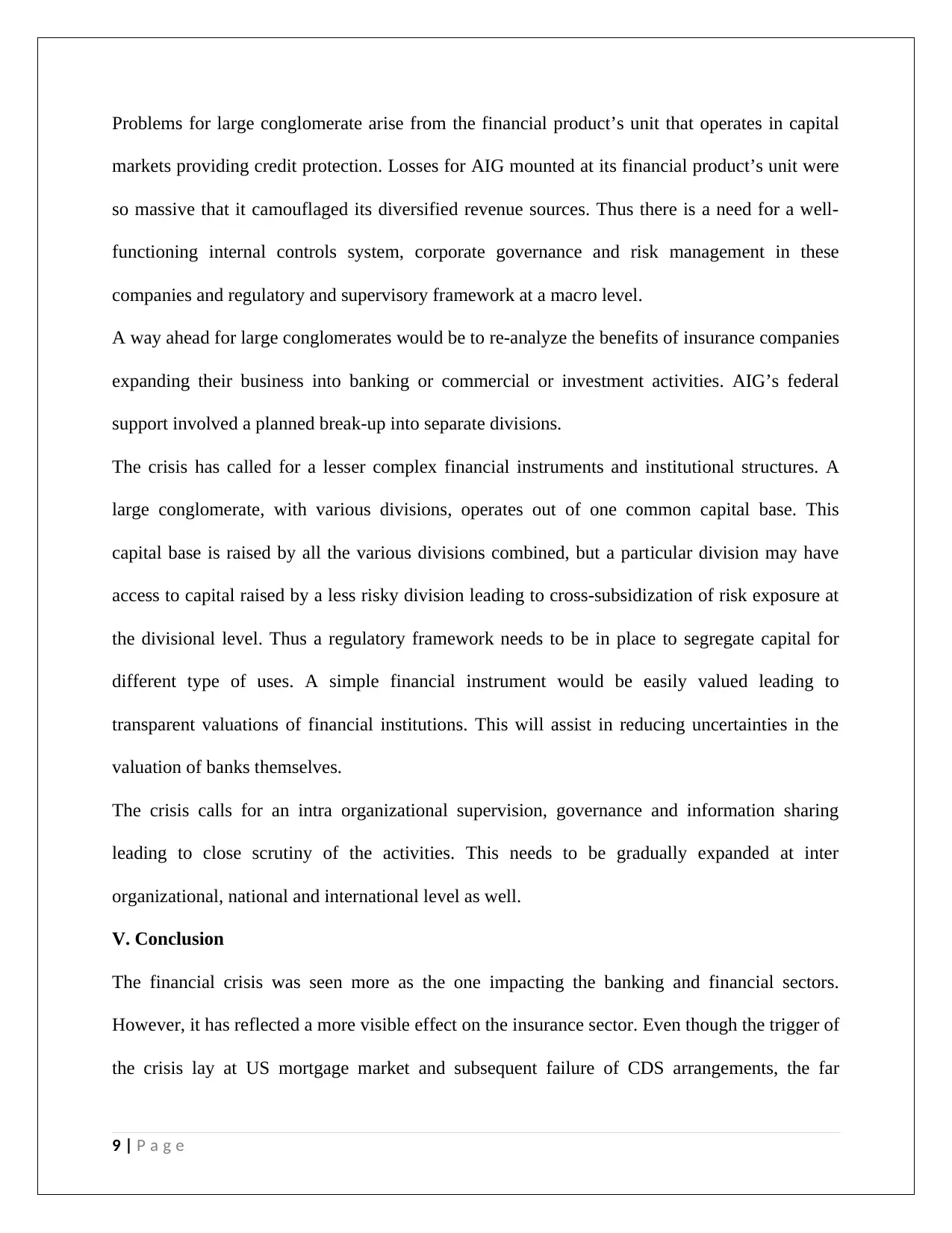
Problems for large conglomerate arise from the financial product’s unit that operates in capital
markets providing credit protection. Losses for AIG mounted at its financial product’s unit were
so massive that it camouflaged its diversified revenue sources. Thus there is a need for a well-
functioning internal controls system, corporate governance and risk management in these
companies and regulatory and supervisory framework at a macro level.
A way ahead for large conglomerates would be to re-analyze the benefits of insurance companies
expanding their business into banking or commercial or investment activities. AIG’s federal
support involved a planned break-up into separate divisions.
The crisis has called for a lesser complex financial instruments and institutional structures. A
large conglomerate, with various divisions, operates out of one common capital base. This
capital base is raised by all the various divisions combined, but a particular division may have
access to capital raised by a less risky division leading to cross-subsidization of risk exposure at
the divisional level. Thus a regulatory framework needs to be in place to segregate capital for
different type of uses. A simple financial instrument would be easily valued leading to
transparent valuations of financial institutions. This will assist in reducing uncertainties in the
valuation of banks themselves.
The crisis calls for an intra organizational supervision, governance and information sharing
leading to close scrutiny of the activities. This needs to be gradually expanded at inter
organizational, national and international level as well.
V. Conclusion
The financial crisis was seen more as the one impacting the banking and financial sectors.
However, it has reflected a more visible effect on the insurance sector. Even though the trigger of
the crisis lay at US mortgage market and subsequent failure of CDS arrangements, the far
9 | P a g e
markets providing credit protection. Losses for AIG mounted at its financial product’s unit were
so massive that it camouflaged its diversified revenue sources. Thus there is a need for a well-
functioning internal controls system, corporate governance and risk management in these
companies and regulatory and supervisory framework at a macro level.
A way ahead for large conglomerates would be to re-analyze the benefits of insurance companies
expanding their business into banking or commercial or investment activities. AIG’s federal
support involved a planned break-up into separate divisions.
The crisis has called for a lesser complex financial instruments and institutional structures. A
large conglomerate, with various divisions, operates out of one common capital base. This
capital base is raised by all the various divisions combined, but a particular division may have
access to capital raised by a less risky division leading to cross-subsidization of risk exposure at
the divisional level. Thus a regulatory framework needs to be in place to segregate capital for
different type of uses. A simple financial instrument would be easily valued leading to
transparent valuations of financial institutions. This will assist in reducing uncertainties in the
valuation of banks themselves.
The crisis calls for an intra organizational supervision, governance and information sharing
leading to close scrutiny of the activities. This needs to be gradually expanded at inter
organizational, national and international level as well.
V. Conclusion
The financial crisis was seen more as the one impacting the banking and financial sectors.
However, it has reflected a more visible effect on the insurance sector. Even though the trigger of
the crisis lay at US mortgage market and subsequent failure of CDS arrangements, the far
9 | P a g e
⊘ This is a preview!⊘
Do you want full access?
Subscribe today to unlock all pages.

Trusted by 1+ million students worldwide
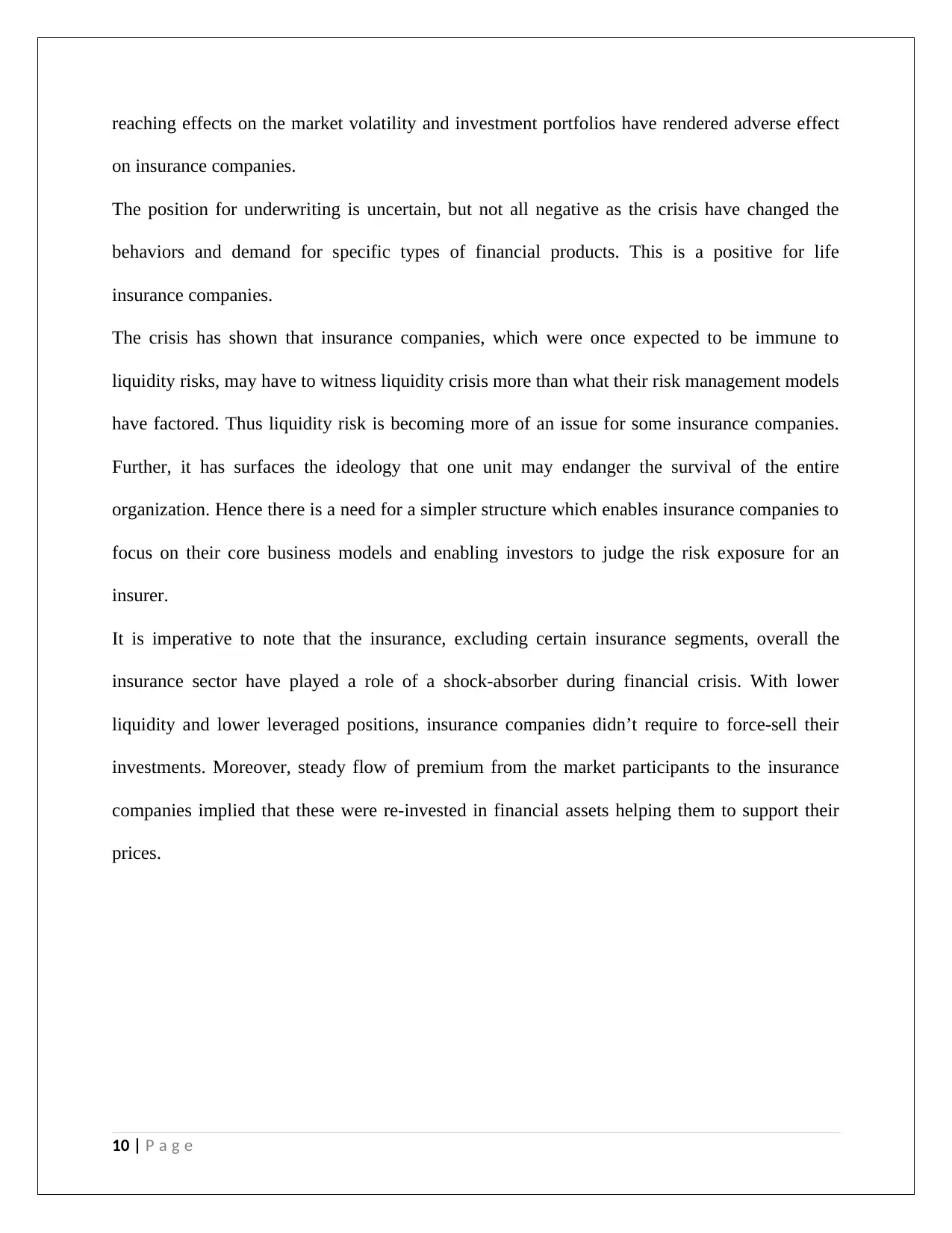
reaching effects on the market volatility and investment portfolios have rendered adverse effect
on insurance companies.
The position for underwriting is uncertain, but not all negative as the crisis have changed the
behaviors and demand for specific types of financial products. This is a positive for life
insurance companies.
The crisis has shown that insurance companies, which were once expected to be immune to
liquidity risks, may have to witness liquidity crisis more than what their risk management models
have factored. Thus liquidity risk is becoming more of an issue for some insurance companies.
Further, it has surfaces the ideology that one unit may endanger the survival of the entire
organization. Hence there is a need for a simpler structure which enables insurance companies to
focus on their core business models and enabling investors to judge the risk exposure for an
insurer.
It is imperative to note that the insurance, excluding certain insurance segments, overall the
insurance sector have played a role of a shock-absorber during financial crisis. With lower
liquidity and lower leveraged positions, insurance companies didn’t require to force-sell their
investments. Moreover, steady flow of premium from the market participants to the insurance
companies implied that these were re-invested in financial assets helping them to support their
prices.
10 | P a g e
on insurance companies.
The position for underwriting is uncertain, but not all negative as the crisis have changed the
behaviors and demand for specific types of financial products. This is a positive for life
insurance companies.
The crisis has shown that insurance companies, which were once expected to be immune to
liquidity risks, may have to witness liquidity crisis more than what their risk management models
have factored. Thus liquidity risk is becoming more of an issue for some insurance companies.
Further, it has surfaces the ideology that one unit may endanger the survival of the entire
organization. Hence there is a need for a simpler structure which enables insurance companies to
focus on their core business models and enabling investors to judge the risk exposure for an
insurer.
It is imperative to note that the insurance, excluding certain insurance segments, overall the
insurance sector have played a role of a shock-absorber during financial crisis. With lower
liquidity and lower leveraged positions, insurance companies didn’t require to force-sell their
investments. Moreover, steady flow of premium from the market participants to the insurance
companies implied that these were re-invested in financial assets helping them to support their
prices.
10 | P a g e
Paraphrase This Document
Need a fresh take? Get an instant paraphrase of this document with our AI Paraphraser
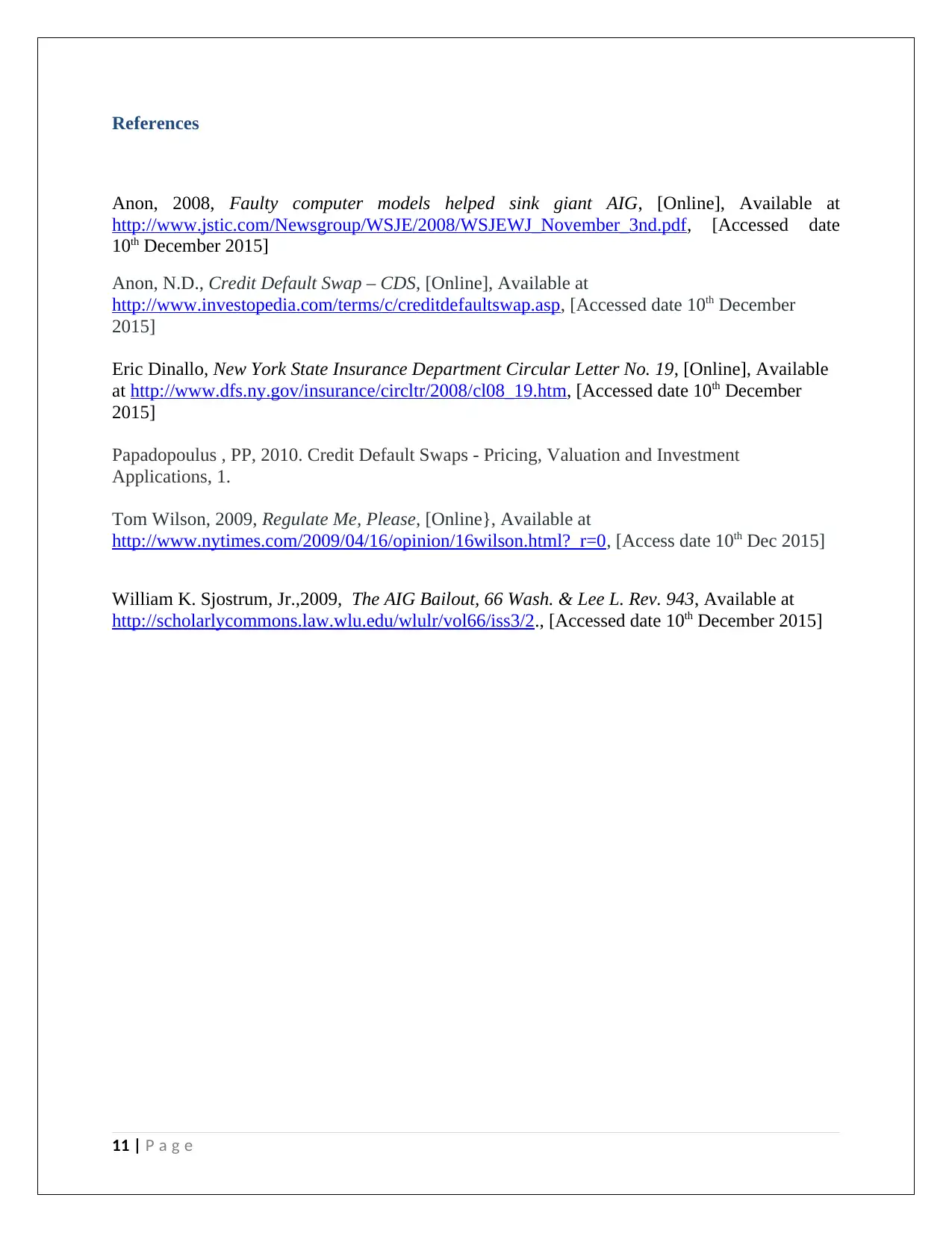
References
Anon, 2008, Faulty computer models helped sink giant AIG, [Online], Available at
http://www.jstic.com/Newsgroup/WSJE/2008/WSJEWJ_November_3nd.pdf, [Accessed date
10th December 2015]
Anon, N.D., Credit Default Swap – CDS, [Online], Available at
http://www.investopedia.com/terms/c/creditdefaultswap.asp, [Accessed date 10th December
2015]
Eric Dinallo, New York State Insurance Department Circular Letter No. 19, [Online], Available
at http://www.dfs.ny.gov/insurance/circltr/2008/cl08_19.htm, [Accessed date 10th December
2015]
Papadopoulus , PP, 2010. Credit Default Swaps - Pricing, Valuation and Investment
Applications, 1.
Tom Wilson, 2009, Regulate Me, Please, [Online}, Available at
http://www.nytimes.com/2009/04/16/opinion/16wilson.html?_r=0, [Access date 10th Dec 2015]
William K. Sjostrum, Jr.,2009, The AIG Bailout, 66 Wash. & Lee L. Rev. 943, Available at
http://scholarlycommons.law.wlu.edu/wlulr/vol66/iss3/2., [Accessed date 10th December 2015]
11 | P a g e
Anon, 2008, Faulty computer models helped sink giant AIG, [Online], Available at
http://www.jstic.com/Newsgroup/WSJE/2008/WSJEWJ_November_3nd.pdf, [Accessed date
10th December 2015]
Anon, N.D., Credit Default Swap – CDS, [Online], Available at
http://www.investopedia.com/terms/c/creditdefaultswap.asp, [Accessed date 10th December
2015]
Eric Dinallo, New York State Insurance Department Circular Letter No. 19, [Online], Available
at http://www.dfs.ny.gov/insurance/circltr/2008/cl08_19.htm, [Accessed date 10th December
2015]
Papadopoulus , PP, 2010. Credit Default Swaps - Pricing, Valuation and Investment
Applications, 1.
Tom Wilson, 2009, Regulate Me, Please, [Online}, Available at
http://www.nytimes.com/2009/04/16/opinion/16wilson.html?_r=0, [Access date 10th Dec 2015]
William K. Sjostrum, Jr.,2009, The AIG Bailout, 66 Wash. & Lee L. Rev. 943, Available at
http://scholarlycommons.law.wlu.edu/wlulr/vol66/iss3/2., [Accessed date 10th December 2015]
11 | P a g e
1 out of 11
Your All-in-One AI-Powered Toolkit for Academic Success.
+13062052269
info@desklib.com
Available 24*7 on WhatsApp / Email
![[object Object]](/_next/static/media/star-bottom.7253800d.svg)
Unlock your academic potential
Copyright © 2020–2025 A2Z Services. All Rights Reserved. Developed and managed by ZUCOL.